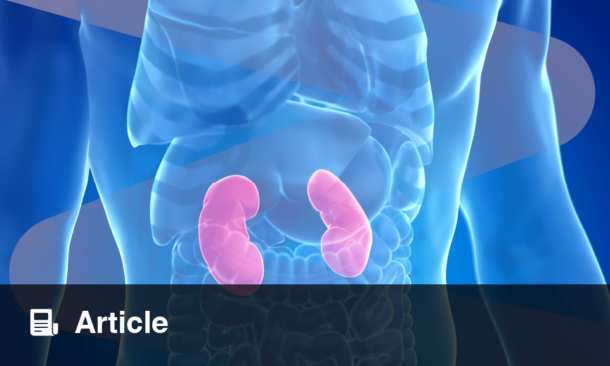RETHINKING kidney health and transforming kidney care was the theme for the 61st European Renal Association (ERA) Congress, which took place in Stockholm, Sweden, between the 23rd–26th May. As the location of the first Nobel Prizes in Physics, Chemistry, Physiology or Medicine, and Literature; Stockholm provided an ideal backdrop for the event.
This year, the congress saw an attendance of 7,448 delegates. The programme comprised 47 main symposia and 26 free communication sessions; with over 2,200 abstracts from 82 countries submitted. With a programme dedicated to improving kidney health and the education around lifestyle and risk factors, the seven main tracks for the Congress were physiology, cell biology, and genetic diseases; glomerular and tubule-interstitial diseases; chronic kidney disease (CKD); dialysis; kidney transplantation; hypertension and diabetes; and acute kidney injury and critical care nephrology.
The Welcome Ceremony saw local Congress President, Peter Stenvinkel, welcome delegates and deliver a thought-provoking speech on the progress made in nephrology, and how planetary health and interconnectedness could help shed light on further understanding kidney disease and developing novel therapeutic targets.
Stenvinkel discussed that despite being known as the discipline of negative trials for many years, new understanding has paved the way for remarkable advances, including over 12 clinical trials in IgA nephritis at present. He drew focus to the late-breaking clinical trials sessions, emphasising to the audience that: “We are part of the most exciting times in nephrology.”
Considering the focus on planetary health, Stenvinkel spoke on the contribution of global warming and air pollution in causing new cases of kidney disease globally, and that worldwide CKD prevalence is a barometer of planetary health; noting that the environment is an emerging concern for the field of nephrology. He explained that planetary health is the science of interconnectedness and stressed that healthcare professionals need to learn how to connect the dots and embrace interdisciplinary collaboration. Understanding of the interconnectedness and influence of multiple factors, including diet, lifestyle, genetics, and the environment on kidney health, will help to elucidate novel pathways underlying kidney disease development and progression. Stenvinkel implored that researchers can harness the butterfly effect by adopting a comprehensive approach to studying kidney disease and examining how seemingly unrelated factors interact to uncover novel insights into disease mechanisms and potential novel therapeutic targets. He stated: “By acknowledging the interconnected nature of biological systems and environmental factors, we can pave the way for innovative, natural approaches to prevention, diagnosis, and treatment of kidney disease.”
Following this, Stenvinkel invited His Royal Highness, Prince Daniel, Prince of Sweden and Duke of Vastergotland, to join the stage. Prince Daniel reflected on his own personal experience as a renal transplant recipient and discussed the enormous burden CKD has on healthcare systems, which is of particular importance as the global prevalence rises. He highlighted global inequalities in access to treatment, which underscores the urgent need for continued efforts in research, education, and policy advocacy, and also stressed that the environmental factors that impact kidney disease (climate change, pollution, and water shortages) must be addressed. He concluded by expressing gratitude to those who dedicate their lives to improving opportunities for patients, before leaving the stage.
The Welcome Ceremony then saw ERA President, Christoph Wanner, deliver the Presidential Address. Wanner placed emphasis on the four late-breaking clinical trial sessions offered in this year’s programme, which is more than ever before. With hope for the future, he noted that there are many news therapeutics on the horizon to be investigated. However, he stressed that in order to carry the success of renal medicine ahead, these therapeutics and patients with kidney disease need to be given the chance to be included in clinical studies. Noting that whilst science is global, implementation is local, as the field strives to bring medications to those who need them; Wanner called on healthcare providers, authorities, and players in Europe to action, to evaluate the four foundational therapies that can help prevent patients from progressing to dialysis.
Spotlighting clinical science, education, and the transfer of knowledge to patients, as the main goals of ERA, Wanner expressed his hope to see this become a reality in the future, before moving on to present this year’s awards and diplomas. Albert Ong, Chair of the Scientific Committee, was called to the stage to receive a diploma in honour of his service to delivering the 2024 ERA Congress programme.
Subsequently, Wanner presented the 2024 ERA awards. These included the award for outstanding clinical contributions to nephrology, presented to Jack Wetzels, Radboud University, Nijmegen, the Netherlands; the award for outstanding basic science contributions to nephrology, bestowed to Ariela Benigni, Mario Negri Institute, Bergamo, Italy; and the award for research excellence in nephrology, granted to Kerstin Amann, University of Erlangen, Germany. Alongside these, two new awards for outstanding contribution to the society and excellence in the field of sustainable nephrology were presented to Mehmet Sükrü Sever, Istanbul University, School of Medicine, Türkiye; and Giorgina Piccoli, Centre Hospitalier Le Mans, Torino, Italy, respectively.
Wanner also presented awards to acknowledge young investigators who stimulate the dialogue between research and education. Jeroen de Baaji, Radboud University Medical Centre, Nijmegen, the Netherlands, received the Rosanna Gusmano Award for Young Investigators in basic science; the Eberhard Ritz Award for Young Investigators in clinical science was awarded to Andreas Kronbichler, University Hospital Innsbruck, Austria; and the Stanley Shaldon Award for Young Investigators in translational science was awarded to both Elisabet Van Loon and Jasper Callemeyn, University Hospital Leuven, Belgium.
Following the award presentations, the Welcome Ceremony concluded with a performance by the Super Trouper ABBA-show, to celebrate the 50-year anniversary since winning the Eurovision Song Contest.
EMJ were thrilled to be part of the 2024 Congress, and look forward to attending the 2025 ERA Congress, which will take place in Vienna, Austria. Until then, read on to enjoy highlights presented at this year’s Congress.
Semaglutide Reduces Major Kidney Events in Patients with Type 2 Diabetes
RESEARCH presented at the 61st ERA Congress by Vlado Perkovic, University of New South Wales, The George Institute, and Royal North Shore Hospital, Sydney, Australia, has shown the potential of semaglutide, a glucagon-like peptide-1 (GLP-1) receptor agonist, in improving patient outcomes.
Findings demonstrated that semaglutide can significantly lower the risk of major kidney disease events, cardiovascular outcomes, and all-cause mortality in patients with Type 2 diabetes and chronic kidney disease (CKD).
The FLOW study (Evaluate Renal Function with Semaglutide Once Weekly) investigated how semaglutide can potentially benefit patients with Type 2 diabetes and CKD. The randomised, double-blind, placebo-controlled trial involved 3,533 patients over a median follow-up period of 3.4 years. Patients were randomly assigned to receive either a weekly subcutaneous injection of semaglutide at 1.0 mg or a placebo.
Results showed that patients receiving semaglutide experienced a 24% reduction in the risk of composite primary endpoint, which included major kidney outcomes and death, resulting from cardiovascular and kidney causes, compared to placebo patients. The reduction risk was consistent across both cardiovascular and kidney-specific related death outcomes. Semaglutide also improved secondary endpoints; the total estimated glomerular filtration rate slope was 1.16 mL/min/1.73 m2/year slower in the semaglutide group, indicating a slower decline in kidney function. Additionally, there was an 18% reduction in the risk of major cardiovascular events and a 20% reduction in all-cause mortality among patients given semaglutide.
This study’s findings highlight the potential clinical implications of semaglutide, which not only reduces the risk of major kidney and cardiovascular events, but also significantly lowers the risk of all-cause mortality. This substantially highlights the potential of semaglutide to transform treatment strategies for high-risk patients. The promising results of the FLOW trial show semaglutide as a crucial therapeutic option, potentially reshaping the management of kidney and cardiovascular health in patients with Type 2 diabetes.
New Technique Detects Novel Biomarkers for Kidney Diseases with Nephrotic Syndrome
RESEARCHERS discovered that anti-nephrin autoantibodies serve as a reliable biomarker for tracking disease progression in nephrotic syndrome, and presented their findings at the 61st ERA Congress.
Nephrotic syndrome is an immune-mediated podocytopathy, leading to protein leakage into the urine and elevated proteinuria. Kidney diseases such as minimal change disease (MCD), primary focal segmental glomerulosclerosis, and membranous nephropathy (MN) are linked to the manifestation of nephrotic syndrome. Diagnosis of idiopathic nephrotic syndrome (INS) is often made in children with MCD and focal segmental glomerulosclerosis. Diagnosing these conditions has traditionally been challenging because of overlapping histological features and the hesitance to conduct invasive biopsies, especially in children. The identification of novel nephrotic syndrome biomarkers paves the way for potential personalised treatment approaches.
A multicentre study conducted across Europe and the USA analysed anti-nephrin autoantibodies in 539 patients with glomerular diseases, introducing a novel technique combining immunoprecipitation with enzyme-linked immunosorbent assay to detect anti-nephrin autoantibodies reliably. Findings showed these autoantibodies were present in 69% of adults with MCD and 90% of children with INS who had not been treated with immunosuppressive drugs. The levels of these autoantibodies correlated with disease activity, suggesting their potential as a biomarker for monitoring disease progression. These antibodies were rarely observed in other kidney diseases studied. Moreover, the research group created an experimental mouse model through active immunisation with recombinant mouse nephrin, which induced a condition similar to MCD. This led to nephrin phosphorylation and significant changes in cell structure, indicating that antibodies targeting nephrin contribute to podocyte malfunction and nephrotic syndrome. Remarkably, this model induced rapid disease manifestation with a single immunisation, even at low antibody concentrations.
Co-lead author of the study, Nicola M. Tomas, University Medical Center Hamburg-Eppendorf, Germany, commented: “The identification of anti-nephrin autoantibodies as a reliable biomarker, combined with our hybrid immunoprecipitation technique, enhances our diagnostic capabilities and opens new avenues for closely monitoring disease progression in kidney disorders with nephrotic syndrome.” Tobias B. Huber, University Medical Center Hamburg-Eppendorf, also a co-lead author of the study, concluded: “By providing insights into underlying mechanisms, these findings lay the groundwork for personalized interventions and pave the way for a new era of precision medicine for these complex conditions.”
Iptacopan Delivers New Hope for C3 Glomerulopathy
IPTACOPAN significantly and meaningfully reduced proteinuria in patients with C3 glomerulopathy (C3G) at 6 months, according to results from the APPEAR-C3G study, presented at the ERA Congress 2024.
C3G is an ultra-rare and severe proliferative glomerulonephritis, characterised by the dysregulation of the alternative complement pathway (AP). Iptacopan, a proximal complement inhibitor, selectively targets Factor B, thereby inhibiting the AP. The APPEAR-C3G Phase III study was designed to assess the efficacy, safety, and tolerability of iptacopan in comparison to placebo for patients with C3G.
APPEAR-C3G was a multicentre, randomised, double-blind, parallel-group, placebo-controlled, pivotal trial. It included 74 adult patients with biopsy-confirmed C3G, reduced serum C3 levels (<77 mg/dL), urinary protein-to-creatinine ratio (UPCR) of ≥1.0 g/g, and estimated glomerular filtration rate (eGFR) of ≥30 mL/min/1.73 m². All participants received the maximum tolerated dose of renin-angiotensin-aldosterone system blockade and vaccinations against encapsulated bacteria before randomisation. The study involved a screening period of up to 90 days, a 6-month randomised double-blind treatment phase (iptacopan 200 mg two times a day versus placebo), and a 6-month open-label iptacopan treatment phase. Historical eGFR data from 2 years prior to screening were used in pre-specified exploratory statistical analyses. The primary objective was to demonstrate the superiority of iptacopan over placebo in reducing proteinuria, measured by UPCR, after 6 months.
Out of 132 screened patients, 74 were randomised (1:1) to receive either iptacopan (n=38) or placebo (n=36). At 6 months, iptacopan showed a significant reduction in 24-hour UPCR, compared to placebo. Patients on iptacopan had a seven-fold increase in the odds of achieving the composite endpoint of ≥50% proteinuria reduction and stable eGFR. There was an improvement in eGFR (+2.2 mL/min/1.73 m²; nominal 1-sided p=0.1945) with iptacopan, as well as a reduction in total histologic disease activity score. Iptacopan significantly increased serum C3 (185%), and decreased AP activity (37.3%), plasma sC5b-9 (65.1%), and urinary sC5b9/creatine (77.3%). It exhibited a favourable safety profile with no new safety signals, no deaths, and minimal serious adverse events. One serious pneumococcal infection, likely related to iptacopan, was successfully treated with antibiotics.
Results from the APPEAR-C3G trial demonstrated that the use of iptacopan significantly, meaningfully, and safely reduces UPCR and proteinuria in patients with C3G, with a positive trend in eGFR improvement.
Atrasentan Significantly Reduces Proteinuria Associated with IgA Nephropathy
RESULTS from ALIGN, an ongoing, Phase III clinical trial, demonstrate that atrasentan, a selective endothelin A (ETA) receptor antagonist, reduces proteinuria in patients with IgA nephropathy (IgAN) at high risk of kidney function loss.
The findings were presented at the 61st ERA Congress, which took place in Stockholm, Sweden, between 23rd–26th May 2024.
Hiddo J.L. Heerspink, University Medical Center Groningen, the Netherlands, and colleagues, investigated the efficacy and safety of atrasentan, including its impact on proteinuria, kidney inflammation, and fibrosis. The trial consisted of 340 patients with biopsy-proven IgAN, with proteinuria of at least 1 g/day. For the primary analysis, 270 patients were randomised to receive either atrasentan 0.75 mg or placebo daily for 132 weeks, alongside their standard medication routine. The researchers evaluated changes in proteinuria by measuring the urine protein to creatinine ratio (UPCR) from 24-hour urine collections, comparing baseline levels to those at Week 36. UPCR reductions in atrasentan-treated patients were seen as early as the first 6 weeks of treatment, and at Week 36 patients treated with atrasentan experienced a 36.1% greater reduction in the mean percentage change in UPCR from baseline, compared to those who received placebo (p<0.0001).
Additionally, the researchers investigated the safety of atrasentan in this patient cohort. There were significantly more instances of fluid retention (11.2% versus 8.2%), anaemia (8.3% versus 2.4%), and hypotension (5.9% versus 4.1%) in patients receiving atrasentan, compared to placebo. However, the number of moderate, severe, and serious treatment-emergent adverse events were similar between those receiving atrasentan and those with placebo.
The interim results of ALIGN have demonstrated that atrasentan significantly reduced proteinuria in patients with IgAN, without an increase in moderate, severe, or serious treatment-emergent adverse events. Additionally, in a future report, the final analysis of ALIGN will elucidate the effect of atrasentan on glomerular filtration rates. The researchers will also report the results of atrasentan usage in patients also receiving sodium-glucose transport protein 2 inhibitor. Nevertheless, the current results indicate that atrasentan is a safe and effective treatment for proteinuria associated with IgAN.
BMI Impacts Mortality Risk Differently in Dialysis Patients
RESEARCH at the 61st ERA Congress investigated the association between the different effects of BMI on all-cause mortality in patients with diabetes who are undergoing different types of dialysis: maintenance haemodialysis (HD) and peritoneal dialysis (PD).
The study used data from the Swedish Renal Registry (SRR), which included 3,235 patients who are diabetic and on dialysis. Of those, 2,452 patients were on HD and 783 were on PD. The patients were divided into six groups based on BMI categories, defined by the World Health Organization (WHO). The follow-up period was 3.9±3.5 years, and patients who switched dialysis types during the study were excluded.
Results showed that patients on HD with a low BMI of ≤18.5 had a significantly higher risk of all-cause mortality compared to the reference group (18.5<BMI≤25.0 kg/m2), with a hazard ratio (HR) of 1.94. Meanwhile, patients on HD with high BMIs of 25.1–30.0 kg/m² (HR: 0.84; classed as overweight), 30.1–35.0 kg/m² (HR: 0.66; Class 1 obesity), and 35.1-40.0 kg/m² (HR: 0.65; Class 2 obesity) had a lower risk of mortality compared to the reference group. This suggests that patients on HD with high BMIs are not at high risk of mortality. However, patients on PD have shown no significant association between BMI and all-cause mortality across all BMI categories. This indicates that BMI may not be a critical factor in predicting mortality risks for patients on PD.
The study concluded that patients with diabetes who are overweight and undergoing maintenance HD face an increased risk of all-cause mortality. Patients who are overweight or have Class 1 or Class 2 obesity showed a significant link to better survival rates. However, in patients who are diabetic and on PD, BMI did not significantly influence mortality risk. These findings highlight the importance of keeping different dialysis types under consideration when evaluating the impact of BMI on survival outcomes in patients who are diabetic.
IL-6 Inhibition in Patients with Cardiovascular Disease and Diabetes
INFLAMMATORY biomarkers associated with cardiovascular events and diabetes are significantly reduced with clazakizumab, according to research presented at the 2024 ERA Congress.
Glenn Chertow, Stanford University School of Medicine, USA, and colleagues, presented the findings of Phase IIb of the POSIBIL6ESKD trial, which assessed the impact of IL-6 inhibition with clazakizumab in patients with cardiovascular disease or diabetes on dialysis.
In the trial, 127 patients received a low, medium, or high dose of clazakizumab or placebo every 4 weeks for up to six doses. At Week 12, the geometric mean ratio to baseline serum high-sensitivity C-reactive protein (hs-CRP) concentration was compared between groups.
It was found that treatment with clazakizumab significantly reduced hs-CRP at Week 12 in the low, medium, and high dose groups, compared to placebo (decreased by 89%, 92%, and 93%, respectively; p<0.0001). Whilst no patients in the placebo group achieved normalisation of hs-CRP (<2.0 mg/L), it was achieved in 79.2%, 82.1%, and 79.3% in the low, medium, and high dose groups, respectively. The results demonstrated that clazakizumab caused significant reductions in the following downstream IL-6 biomarkers: fibrinogen, serum amyloid A, secretory phospholipase A2, and lipoprotein(a). Furthermore, there was an increase of at least 0.17 g/dL of mean serum albumin in those treated with clazakizumab. Regarding the safety and tolerability of clazakizumab, there were no cases of sustained Grade 3 or 4 thrombocytopenia or neutropenia.
The results of the POSIBIL6ESKD trial demonstrated that clazakizumab is safe for reducing inflammatory biomarkers in patients with cardiovascular disease or diabetes dialysis. These findings suggest that clazakizumab may reduce the risk of cardiovascular mortality and morbidity associated with IL-6 and its downstream biomarkers in these patients, highlighting its potential as a therapeutic option to improve cardiovascular outcomes in this high-risk population.
Pollution’s Hidden Toll: Kidney Disease Mortality
AIR pollution has been associated with chronic kidney disease (CKD)-related mortality, according to results from a study by Emanuel Zitt and team, presented at the ERA Congress 2024.
Air pollution has previously been linked to various cause-specific mortalities, yet its impact on CKD-related mortality remains under-researched, particularly within Europe. This study aimed to investigate the relationship between long-term air pollution exposure and CKD-associated mortality using data from Effects of Low-Level Air Pollution: A Study in Europe (ELAPSE).
Data were collected from five population-based cohorts across four European countries, which were pooled into the ELAPSE cohort. Mortality data were obtained from local registries, identifying CKD-associated deaths, and annual mean exposure levels at home addresses were estimated using Europe-wide hybrid land use regression models for nitrogen dioxide (NO2), black carbon (BC), ozone (O3), particulate matter ≤2.5µm (PM2.5), and several elemental constituents of PM2.5 with a spatial resolution of 100 m2. Cox regression models adjusted for age (time-axis), cohort and sex (strata), calendar year of recruitment, smoking status, marital status, employment status, and neighbourhood mean income were employed to analyse the data.
Over a mean follow-up period of 20.4 years, 313 out of the 289,564 included individuals died from CKD. Positive associations were observed for PM2.5 (hazard ratio [HR]: 1.31; 95% CI: 1.03–1.66; per 5 µg/m3 increase), BC (HR: 1.26; 95% CI: 1.03–1.53; per 0.5×10−5/m), and NO2 (HR: 1.13; 95% CI: 0.93–1.38; per 10 µg/m3). Conversely, O3 showed a negative association (HR: 0.71; 95% CI: 0.54–0.93; per 10 µg/m3). These results remained robust after additional adjustments for smoking intensity and duration, BMI, education, and residential greenness; but were sensitive to cohort selection, with the large Austrian cohort contributing 226 cases. Elemental constituents such as copper, iron, potassium, nickel, sulfur, and zinc, associated with various PM2.5 sources (traffic, industry, biomass and oil burning, and long-range transport), were also linked to CKD-related mortality.
The results from this study suggest a possible association between air pollution and CKD-related mortality. This indicates that improving air quality may benefit renal health, highlighting the importance of air pollution control measures as health measures.
Prednisolone Dosage Comparison: Remission and Safety
MINIMAL change disease (MCD) is typically treated with high-dose prednisolone, and these have notable side effects.
Observations suggest that active vitamin D might stabilise the glomerular filtration barrier, reducing albuminuria and benefiting patients with MCD. Findings from a trial that evaluated whether combining lower-dose prednisolone with alfacalcidol would be as effective as high-dose prednisolone in achieving remission and time to remission in patients with MCD, potentially with fewer adverse effects, were presented at the 61st ERA Congress.
In a Danish, multicentre, prospective, open-label, randomised controlled trial, adults with confirmed MCD and nephrotic syndrome were enrolled. Patients were randomised 1:1 to receive either prednisolone 1 mg/kg/day or prednisolone 0.5 mg/kg/day with alfacalcidol 0.5 μg daily. Doses remained the same for 4–16 weeks if remission was not achieved. Remission denotes the urine albumin-creatinine ratio <300 mg/g in two samples. Upon remission, prednisolone was tapered over 25 weeks. Patients were followed for up to a year post-remission. Primary endpoints were time to remission and remission rate, while secondary endpoints included adverse events. The mean follow-up was 40.8 weeks.
A total of 70 patients were randomised equally into two treatment groups, out of which three were excluded due to diagnosis revision or protocol violation but were included in the intention-to-treat analyses. Baseline characteristics were similar. The cumulative prednisolone dose until remission was significantly lower in the lower-dose prednisolone/alfacalcidol group (1,413 mg versus 2,240 mg in the higher dose group; p=0.002). The overall remission rate was 86%, with similar rates between the two groups (p=0.502). Median time to remission was also comparable (23 days [interquartile range: 12–43] for high-dose prednisolone versus 25 days [interquartile range: 15–35] for lower-dose prednisolone/alfacalcidol; p=0.430). Results were consistent even after excluding the three patients. Severe adverse events were higher in the high-dose prednisolone group compared to the lower-dose prednisolone/alfacalcidol group (10 versus 6, respectively). The most common severe adverse events were infections, with four cases, all in the high-dose prednisolone group.
Combining prednisolone 0.5 mg/kg/day with alfacalcidol showed similar effectiveness to prednisolone 1 mg/kg/day in achieving remission and time to remission in patients with MCD. Severe adverse events were more frequent with high-dose prednisolone.
Incidence of Post-operative Acute Kidney Injury in Males Compared to Females
ACUTE kidney injury (AKI) impacts approximately 6–8% of patients undergoing general elective surgeries, significantly raising the risk of mortality by three-fold.
Additionally, AKI increases the likelihood of developing chronic kidney disease and end-stage renal disease by eight- and three-fold, respectively. It was previously hypothesised that females were at a higher risk for postoperative AKI; however, recent research presented at ERA Congress 2024 showed that AKI occurs more frequently in hospitalised males than females (odds ratio: 2.2). Moreover, females appear to have a protective advantage against AKI until menopause, suggesting that male sex is a risk factor for AKI. Consequently, the researchers hypothesised that males would have a higher incidence of postoperative AKI than females following radical colorectal surgery. The primary objective of the study was to examine and compare the incidence of postoperative AKI in males and females undergoing radical colorectal surgery.
Researchers used the Cancer and Anesthesia: Survival After Radical Surgery (CAN) study database to conduct a post hoc analysis. Termed the Propofol or Sevoflurane Anesthesia in Colon Cancer (PROSACC) study, it aimed to analyse postoperative AKI incidence. The CAN study was a randomised, multicentre study comprising patients with cancer receiving radical surgery at hospitals in China, Croatia, Poland, and Sweden. Patients enrolled in the study underwent colorectal surgery, and 3,254 patients were included in the analysis. The study’s primary outcome was AKI incidence, which was determined by measuring changes in plasma creatinine, while the secondary outcome was gender association with AKI. The secondary outcome was statistically analysed using Pearson’s chi-square test.
Of the 3,254 patients, 2,741 had their postoperative plasma creatinine levels recorded on postoperative Days 1–3, while 986 patients had their creatinine values measured on Days 4–10. Results revealed that, from Days 1–3, 193 patients developed AKI, of which 6% were female and 8% were male (p=0.190); whereas on Days 4–10, 87 patients developed AKI, of which 6% were female and 11% were male (p=0.004). Moreover, results demonstrated that female sex is associated with a 60% decrease in the odds of AKI.
These findings prompted the authors to conclude that at timepoint 4–10 days following radical colorectal surgery, the incidence of AKI is twice as high in males compared to females. Females in this study had higher preoperative risk factors; therefore, the results align with the hypothesis that male sex is a risk factor for postoperative AKI.
Semaglutide Proves Promising in Protecting Kidney Function in Patients with Cardiovascular Disease and Obesity
DATA from the SELECT trial (Semaglutide Effects on Heart Disease and Stroke in Patients Overweight or Obesity), was presented at the 61st ERA Congress by Helen M Colhoun, Institute of Genetics and Cancer, Edinburgh, UK.
The results revealed that semaglutide significantly reduced major kidney-related complication risk in individuals who are overweight or obese without diabetes.
The multicentre randomised, double-blind, placebo-controlled trial aimed to investigate the potential of semaglutide in combatting renal function decline in 17,604 individuals who were overweight or obese (BMI ≥27 kg/m2) with established cardiovascular disease (prior myocardial infarction, prior stroke, or symptomatic peripheral arterial disease), but without diabetes. Patients were initiated on 0.24 mg and escalated up to the maintenance dose of 2.4 mg by Week 16. The median follow-up was 182 weeks.
The results showed that patients receiving subcutaneous injections of semaglutide at a dose of 2.4 mg once a week experienced 22% fewer adverse kidney-related events (defined using a five-component composite kidney endpoint) compared to individuals in the placebo arm. The five-component composite score comprised: death resulting from kidney causes, initiation of chronic kidney replacement therapy (dialysis or transplantation), onset of a persistent estimated glomerular filtration rate (eGFR) <15mL/min/1.73m², persistent ≥50% reduction in eGFR compared to baseline, and onset of persistent macroalbuminuria.
At 104 weeks, the investigators examined the change in eGFR and urinary albumin-creatinine ratio (UACR) associated with treatment. This revealed that semaglutide recipients showed a significantly lesser decline in eGFR, especially in participants with baseline eGFR below 60 mL/min/1.73 m², indicating better kidney function preservation. However, among semaglutide-treated patients, there was also a substantial decrease in UACR; with reductions of 8.1% in those with normal albumin levels, 27.2% in those with microalbuminuria, and 31.4% in those with macroalbuminuria at baseline compared to placebo.
The study results suggest that semaglutide provides a renal benefit in individuals without diabetes who are overweight or obese, with a 22% reduction in the five-component composite kidney endpoint achieved in those randomised to 2.4 mg of subcutaneous semaglutide once per week. The observed effects on eGFR and UACR suggest enhanced management of kidney complications, and these benefits were most notable in those with an eGFR <60 mL/min/1.73 m² and albuminuria, respectively.







